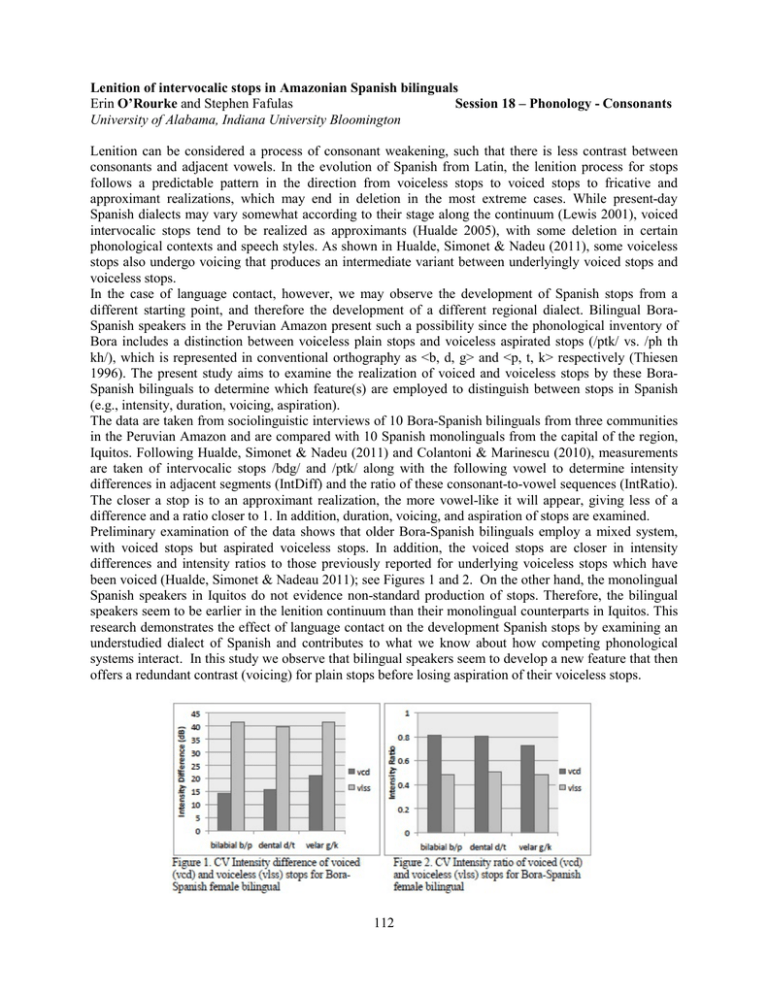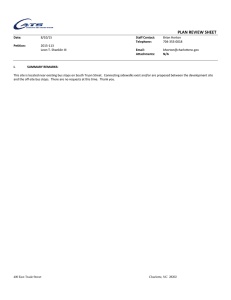112 Lenition of intervocalic stops in Amazonian Spanish bilinguals
advertisement

Lenition of intervocalic stops in Amazonian Spanish bilinguals Erin O’Rourke and Stephen Fafulas Session 18 – Phonology - Consonants University of Alabama, Indiana University Bloomington Lenition can be considered a process of consonant weakening, such that there is less contrast between consonants and adjacent vowels. In the evolution of Spanish from Latin, the lenition process for stops follows a predictable pattern in the direction from voiceless stops to voiced stops to fricative and approximant realizations, which may end in deletion in the most extreme cases. While present-day Spanish dialects may vary somewhat according to their stage along the continuum (Lewis 2001), voiced intervocalic stops tend to be realized as approximants (Hualde 2005), with some deletion in certain phonological contexts and speech styles. As shown in Hualde, Simonet & Nadeu (2011), some voiceless stops also undergo voicing that produces an intermediate variant between underlyingly voiced stops and voiceless stops. In the case of language contact, however, we may observe the development of Spanish stops from a different starting point, and therefore the development of a different regional dialect. Bilingual BoraSpanish speakers in the Peruvian Amazon present such a possibility since the phonological inventory of Bora includes a distinction between voiceless plain stops and voiceless aspirated stops (/ptk/ vs. /ph th kh/), which is represented in conventional orthography as <b, d, g> and <p, t, k> respectively (Thiesen 1996). The present study aims to examine the realization of voiced and voiceless stops by these BoraSpanish bilinguals to determine which feature(s) are employed to distinguish between stops in Spanish (e.g., intensity, duration, voicing, aspiration). The data are taken from sociolinguistic interviews of 10 Bora-Spanish bilinguals from three communities in the Peruvian Amazon and are compared with 10 Spanish monolinguals from the capital of the region, Iquitos. Following Hualde, Simonet & Nadeu (2011) and Colantoni & Marinescu (2010), measurements are taken of intervocalic stops /bdg/ and /ptk/ along with the following vowel to determine intensity differences in adjacent segments (IntDiff) and the ratio of these consonant-to-vowel sequences (IntRatio). The closer a stop is to an approximant realization, the more vowel-like it will appear, giving less of a difference and a ratio closer to 1. In addition, duration, voicing, and aspiration of stops are examined. Preliminary examination of the data shows that older Bora-Spanish bilinguals employ a mixed system, with voiced stops but aspirated voiceless stops. In addition, the voiced stops are closer in intensity differences and intensity ratios to those previously reported for underlying voiceless stops which have been voiced (Hualde, Simonet & Nadeau 2011); see Figures 1 and 2. On the other hand, the monolingual Spanish speakers in Iquitos do not evidence non-standard production of stops. Therefore, the bilingual speakers seem to be earlier in the lenition continuum than their monolingual counterparts in Iquitos. This research demonstrates the effect of language contact on the development Spanish stops by examining an understudied dialect of Spanish and contributes to what we know about how competing phonological systems interact. In this study we observe that bilingual speakers seem to develop a new feature that then offers a redundant contrast (voicing) for plain stops before losing aspiration of their voiceless stops. 112


